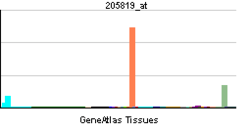MARCO
| View/Edit Human | View/Edit Mouse |
Macrophage receptor MARCO also known as macrophage receptor with collagenous structure (MARCO) is a protein that in humans is encoded by the MARCO gene.[3][4][5][6]
Function
The protein encoded by this gene is a member of the class A scavenger receptor family and is part of the innate antimicrobial immune system. The protein may bind both Gram-negative and Gram-positive bacteria via an extracellular, C-terminal, scavenger receptor cysteine-rich (SRCR) domain.[7][8] In addition to short cytoplasmic and transmembrane domains, there is an extracellular spacer domain and a long, extracellular collagenous domain. The protein may form a trimeric molecule by the association of the collagenous domains of three identical polypeptide chains.[6]
Infused, negatively charged, immune-modifying microparticles (IMPs), derived from polystyrene, microdiamonds, or biodegradable poly(lactic-co-glycolic) acid, are taken up by inflammatory monocytes, in an opsonin-independent fashion, via MARCO. This results in monocyte sequestration in the spleen through apoptotic cell clearance mechanisms. IMPs may therefore be of therapeutic use in diseases caused or potentiated by inflammatory monocytes.[9]
References
- ↑ "Human PubMed Reference:".
- ↑ "Mouse PubMed Reference:".
- ↑ Elomaa O, Sankala M, Pikkarainen T, Bergmann U, Tuuttila A, Raatikainen-Ahokas A, Sariola H, Tryggvason K (Mar 1998). "Structure of the human macrophage MARCO receptor and characterization of its bacteria-binding region". J Biol Chem. 273 (8): 4530–8. doi:10.1074/jbc.273.8.4530. PMID 9468508.
- ↑ Elomaa O, Kangas M, Sahlberg C, Tuukkanen J, Sormunen R, Liakka A, Thesleff I, Kraal G, Tryggvason K (Mar 1995). "Cloning of a novel bacteria-binding receptor structurally related to scavenger receptors and expressed in a subset of macrophages". Cell. 80 (4): 603–9. doi:10.1016/0092-8674(95)90514-6. PMID 7867067.
- ↑ Kangas M, Brännström A, Elomaa O, Matsuda Y, Eddy R, Shows TB, Tryggvason K (Jul 1999). "Structure and chromosomal localization of the human and murine genes for the macrophage MARCO receptor". Genomics. 58 (1): 82–9. doi:10.1006/geno.1999.5811. PMID 10331948.
- 1 2 "Entrez Gene: MARCO macrophage receptor with collagenous structure".
- ↑ Novakowski KE, Huynh A, Han S, Dorrington MG, Yin C, Tu Z, Pelka P, Whyte P, Guarne A, Sakamoto K, Bowdish DM (2016). "A naturally occurring transcript variant of MARCO reveals the SRCR domain is critical for function". Immunol. Cell. Biol. doi:10.1038/icb.2016.20. PMID 26888252.
- ↑ Whelan FJ, Meehan CJ, Golding GB, McConkey BJ, Bowdish DM (2012). "The evolution of the class A scavenger receptors". BMC Evol. Biol. 12: 227. doi:10.1186/1471-2148-12-227. PMC 3567963
 . PMID 23181696.
. PMID 23181696. - ↑ Getts DR, Terry RL, Getts MT, Deffrasnes C, Müller M, van Vreden C, Ashhurst TM, Chami B, McCarthy D, Wu H, Ma J, Martin A, Shae LD, Witting P, Kansas GS, Kühn J, Hafezi W, Campbell IL, Reilly D, Say J, Brown L, White MY, Cordwell SJ, Chadban SJ, Thorp EB, Bao S, Miller SD, King NJ (Jan 2014). "Therapeutic inflammatory monocyte modulation using immune-modifying microparticles.". Sci Transl Med. 6 (219): 219. doi:10.1126/scitranslmed.3007563. PMID 24431111.
Further reading
- Elshourbagy NA, Li X, Terrett J, Vanhorn S, Gross MS, Adamou JE, Anderson KM, Webb CL, Lysko PG (2000). "Molecular characterization of a human scavenger receptor, human MARCO". Eur. J. Biochem. 267 (3): 919–26. doi:10.1046/j.1432-1327.2000.01077.x. PMID 10651831.
- Seta N, Granfors K, Sahly H, Kuipers JG, Song YW, Baeten D, Veys EM, Maksymowych W, Märker-Hermann E, Gu J, Huang F, Kirveskari J, Yu DT (2001). "Expression of host defense scavenger receptors in spondylarthropathy". Arthritis Rheum. 44 (4): 931–9. doi:10.1002/1529-0131(200104)44:4<931::AID-ANR150>3.0.CO;2-T. PMID 11315932.
- Brännström A, Sankala M, Tryggvason K, Pikkarainen T (2002). "Arginine residues in domain V have a central role for bacteria-binding activity of macrophage scavenger receptor MARCO". Biochem. Biophys. Res. Commun. 290 (5): 1462–9. doi:10.1006/bbrc.2002.6378. PMID 11820786.
- Sankala M, Brännström A, Schulthess T, Bergmann U, Morgunova E, Engel J, Tryggvason K, Pikkarainen T (2002). "Characterization of recombinant soluble macrophage scavenger receptor MARCO". J. Biol. Chem. 277 (36): 33378–85. doi:10.1074/jbc.M204494200. PMID 12097327.
- Mirani M, Elenkov I, Volpi S, Hiroi N, Chrousos GP, Kino T (2002). "HIV-1 protein Vpr suppresses IL-12 production from human monocytes by enhancing glucocorticoid action: potential implications of Vpr coactivator activity for the innate and cellular immunity deficits observed in HIV-1 infection". J. Immunol. 169 (11): 6361–8. doi:10.4049/jimmunol.169.11.6361. PMID 12444143.
- Bin LH, Nielson LD, Liu X, Mason RJ, Shu HB (2003). "Identification of uteroglobin-related protein 1 and macrophage scavenger receptor with collagenous structure as a lung-specific ligand-receptor pair". J. Immunol. 171 (2): 924–30. doi:10.4049/jimmunol.171.2.924. PMID 12847263.
- Arredouani MS, Palecanda A, Koziel H, Huang YC, Imrich A, Sulahian TH, Ning YY, Yang Z, Pikkarainen T, Sankala M, Vargas SO, Takeya M, Tryggvason K, Kobzik L (2005). "MARCO is the major binding receptor for unopsonized particles and bacteria on human alveolar macrophages". J. Immunol. 175 (9): 6058–64. doi:10.4049/jimmunol.175.9.6058. PMID 16237101.
- Liu T, Qian WJ, Gritsenko MA, Camp DG, Monroe ME, Moore RJ, Smith RD (2006). "Human Plasma N-Glycoproteome Analysis by Immunoaffinity Subtraction, Hydrazide Chemistry, and Mass Spectrometry". J. Proteome Res. 4 (6): 2070–80. doi:10.1021/pr0502065. PMC 1850943
 . PMID 16335952.
. PMID 16335952.
